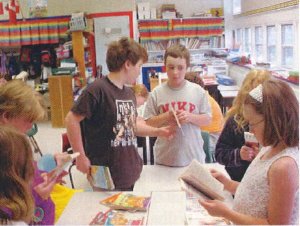
Students also engaged in discussions around the illustrations presented. For example, one group member presented his illustration of a wooden dinghy to the group. Another group member asked what the lines represented. The illustrator explained that the lines were the wooden parts on the dinghy. Two group members challenged the illustrator by commenting that the dinghy was made out of rubber. The illustrator defended his illustration by responding with, "This was the wooden dinghy that Mr. ______ rowed away in".

The discussions continued to grow in
length and complexity. The discussion
component was becoming as much of a
priority for the students as the reading. The
students had taken ownership for their
learning and the literature circles process.
They were also engaged with the text and
with each other.
Extension projects were completed following the two cycles of literature circles based on novels and
nonfiction/information texts. However, the class time to prepare and present these projects was reduced to
two or three class periods. Student projects included writing a script for an important scene from the book,
designing a CD cover to represent their book, preparing a story bag that included items of significance to the
story, dioramas representing a scene from the book, and posters to advertise their book to name but a few. All
extension projects included a summary of the book, the groups' recommendation that included whether they
thought the book would appeal to boys, girls or both, and a presentation to the class.
The grade five teachers' reflections revealed that literature circles were beneficial in differentiating instruction. The researchers repeatedly saw evidence that the group members were supportive of the students with lower level literacy skills. They included these students by reading the text with them and did not discourage them from participating in the discussions. All contributions to the discussions were valued.